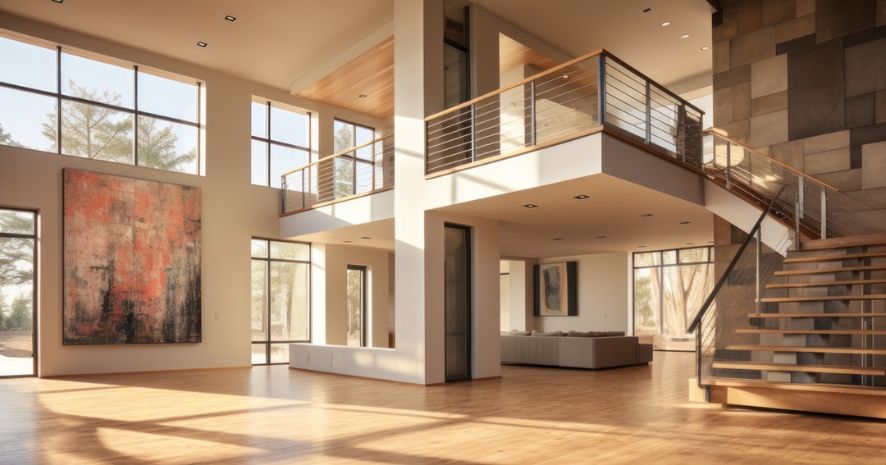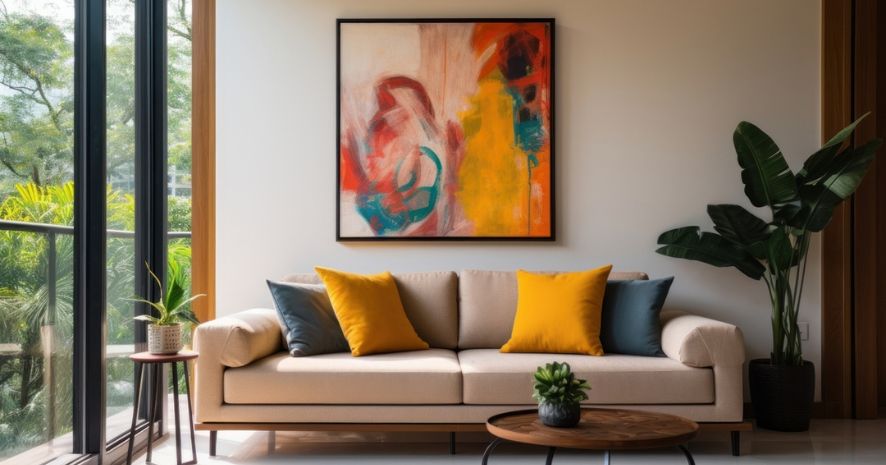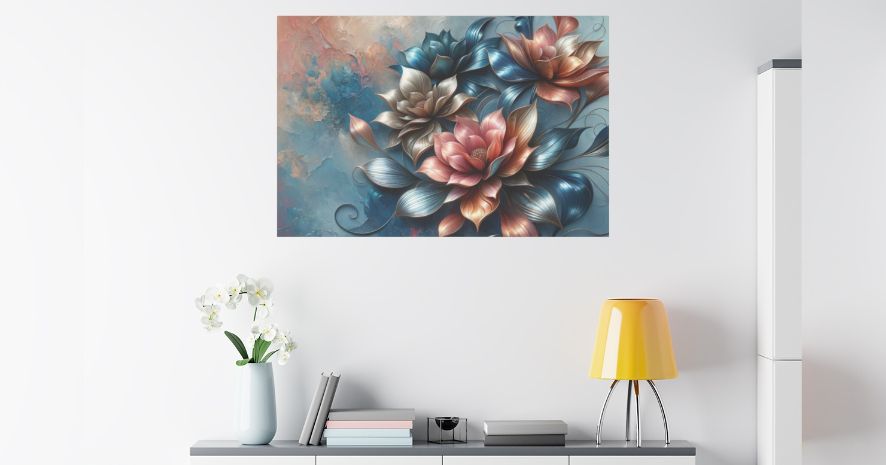The walls of our homes are like blank canvases, eagerly waiting to tell a story. Art, in its myriad forms, has the power to elevate a space, stir emotions, and mirror our personalities. But with the vast world of art – spanning styles, mediums, and eras – the task of choosing the perfect piece can seem daunting.
Whether you’re a seasoned art collector or someone taking their first steps into the world of art acquisition, selecting artwork for your home is more than just a purchase; it’s a journey of self-expression.
In this guide, we’ll delve into the nuances of picking art that not only complements your interiors but resonates with your soul. We’ll introduce four main ways to choose art, ensuring your living spaces become truly yours.
Importance of Art in Home Decor
The walls and corners of our homes are more than just structural entities; they are the backdrop against which we live our lives. While furnishings and color palettes play a significant role in defining our spaces, it is art that adds depth, personality, and soul to them. Let’s delve deeper into the transformative power of art in home decor:
The Emotional Impact of Art
Art has a profound ability to touch the human spirit. Each artwork carries a distinct emotional tone, from the tranquility of a soft-hued landscape to the fiery passion of an abstract piece. Strategically chosen and placed, art can set or augment the mood of a room, making it feel relaxed, energized, contemplative, or romantic.
Beyond mere decoration, art can be therapeutic. The calming strokes of watercolors, the uplifting shades of bright pop art, or the motivational tone of a well-phrased quote can offer solace, joy, and daily inspiration.
Art Reflects Personal Style
Your choice of art is a mirror to your inner self. Over time, as we grow and evolve, our art choices might shift. A room’s gallery wall can become a timeline of personal evolution, chronicling shifts in taste, ideology, or life phases.
While many homes might boast similar furniture or trending color palettes, art offers a layer of uniqueness. It ensures that no two homes are genuinely alike, even if they share similarities. It’s this personalized touch that transforms houses into homes.

Considerations Before Selecting Art
Choosing art for your home is more than just an aesthetic decision; it’s a process that requires thoughtful consideration of various factors. Each room in your home has its own character and purpose, and the art you select should complement and enhance that essence. Here are a few key considerations to keep in mind:
Assessing the Room’s Size and Scale
Before purchasing any artwork, it’s essential to assess the size and scale of the room where it will be placed. Measure the space on your wall where you plan to hang the artwork. An artwork too large can overwhelm a small room, while a piece too small can get lost in a spacious area.
Consider the ceiling height, room width, and overall dimensions. In rooms with high ceilings, taller or vertical artworks can create balance, while horizontal pieces might work better in wider rooms.
Matching Color Schemes and Themes
Art can either be a continuation of a room’s color palette or introduce contrasting elements. If you’re looking to maintain a harmonious feel, choose art that incorporates some of the existing colors in the room. This doesn’t mean the artwork has to match perfectly, but having one or two shared colors can create a cohesive look.
Beyond colors, consider the theme of the room. A coastal-themed room might benefit from marine or beach-inspired artworks, while a modern minimalist space might resonate with abstract art.

Balancing Budget and Quality
Selecting art for your home is an exciting endeavor, but it’s essential to strike a balance between budget and quality. Whether you’re an avid art collector or a first-time buyer, understanding the value and cost of artwork can help you make informed decisions.
Originals vs. Prints
Original artworks are unique pieces created by artists and typically come at a higher price point. They can be a worthwhile investment, not just for their aesthetic appeal but also for potential appreciation in value. Originals often possess texture, depth, and nuances that reproductions might not capture.
Art prints are reproductions of original artworks and are more budget-friendly. Limited edition prints, which are produced in small quantities and often signed by the artist, can still offer a touch of exclusivity without the hefty price tag of an original. Quality prints can be indistinguishable from originals at a glance and can be a great way to adorn your space without breaking the bank.
Exploring Local Art Fairs vs. Online Platforms
Local art fairs can be gold mines for discovering emerging artists and unique pieces at affordable prices. Engaging directly with artists allows for a deeper understanding of the artwork and often provides room for negotiation.
The digital age has democratized art access. Numerous online art galleries and platforms offer a vast selection, from high-end original pieces to affordable prints. Shopping online allows for easy price comparisons, but ensure you’re purchasing from reputable sources to guarantee authenticity and quality.

Arranging and Displaying Art in Your Home
Integrating art into your home goes beyond just selecting pieces; it’s about presenting them in a way that complements your space and showcases their beauty. Here are some expert tips to help you masterfully display art in your home:
The Art of Placement, Wall Hangings and Layouts
Art placement within a room is crucial for maximizing its impact and ensuring it blends harmoniously with the surrounding decor. One key principle to remember is the importance of height. Ideally, the center of the artwork should be at eye level, which is typically around 57 to 60 inches from the floor. Positioning your artwork at this height makes it easily viewable and creates a balanced visual relationship with other furnishings in the room.
For those fortunate enough to have a collection of art pieces, creating a gallery wall can be an enchanting way to showcase your treasures. Though gallery walls can be diverse, it’s essential to maintain a unifying element, whether that’s a consistent color scheme, theme, or frame style.
Lastly, when it comes to arranging multiple artworks side by side, the spacing between them is pivotal. To create a cohesive look, aim for a consistent spacing, usually ranging between 2 to 5 inches.
Using Lighting to Enhance Artwork
Lighting plays an indispensable role in showcasing art. Dedicated art-specific lighting, such as picture lights or track lighting, can be used to shine directly on your artwork. These fixtures have the ability to bring out the rich textures and vivid colors of each piece, ensuring they truly stand out.
However, nothing beats the glow of natural light. If your room design allows, position your artworks where they’ll benefit from the illuminance of the sun. But exercise caution: prolonged exposure to direct sunlight can deteriorate the colors of your art over time. If your chosen spot is sun-drenched, consider using UV-protective glass or frames for added protection.
For evenings or rooms with minimal natural light, incorporating soft, ambient lighting can create a dramatic and inviting mood. This kind of lighting not only accentuates your artwork but also transforms your room into a gallery-like atmosphere.

Incorporating Art into Various Rooms
Each room in your home has its unique essence, and the art within should reflect that.
Living Room
The living room, often the heart of any home, is where families come together, friends gather, and memories are made. Given its significance, the art displayed here should make a resounding impact. Statement pieces or an intricately crafted gallery wall can be an excellent choice.
These pieces not only serve as visual delights but also as conversation starters. Consider artworks that reflect the broader theme of the room, possibly echoing its color scheme or the mood you wish to evoke. Given the room’s communal nature, artworks here should resonate with diverse audiences, all while reflecting your unique taste.
The Bedroom
Bedrooms are deeply personal spaces, sanctuaries where we escape the world and rejuvenate. Art in this space should echo this sense of tranquility. Opt for calming, serene artworks that evoke feelings of relaxation and restfulness.
Given the room’s function, it might be best to select pieces that induce peace rather than provoke intense thought. Positioning artworks above the bed or directly opposite ensures they’re the first and last thing you lay your eyes on, setting the tone for restful nights and inspired mornings.
The Kitchen & Dining Area
Traditionally, kitchens and dining areas might not be the first spaces that come to mind when thinking about art. However, with a bit of creativity, these spaces can transform. Playful, culinary-themed artworks or pieces that introduce vibrant pops of color can rejuvenate these functional areas.
As meals are prepared and shared, art can serve as a backdrop, adding layers of visual flavor. Just remember to ensure artworks are safely positioned, away from areas prone to food splatters or high heat. Framed prints or artworks under glass can also make cleaning easier in these spaces.
The Bathroom
Bathrooms, often smaller and more intimate than other rooms, present a unique canvas for artistic expression. Here, you can introduce moisture-resistant artwork or framed prints that enhance the room’s ambiance.
Given the limited space, smaller pieces that complement the room’s color scheme or theme are ideal. Whether it’s a serene landscape to pair with a relaxing bath or a quirky illustration that adds character, the right art can transform a functional space into a personalized oasis.
Hallways & Staircases
Hallways and staircases, while often overlooked, hold untapped potential for artistic display. These transitional areas connect various rooms and thus can be used to tell a story as one moves from space to space. Sequential artworks or pieces that share a thematic link can be displayed here, guiding individuals on a visual journey.
The linear nature of these spaces also allows for a progression in art displays, whether it’s a gradual shift in color, style, or subject. Turning these often-neglected spaces into galleries makes every journey from one room to another a delightful artistic exploration.

To Summarize
Selecting the perfect art for your home is a transformative journey, intertwining personal tastes with aesthetics to create spaces that truly resonate. Art has the unique ability to elevate everyday living spaces into captivating visual narratives, telling stories of who we are, where we’ve been, and what we cherish.
While we’ve equipped you with the insights and guidelines to embark on this artful endeavor, remember that the most pivotal aspect is the connection you feel with each piece. Let your intuition guide you and embrace art that speaks to your soul.
Ready to bring these insights to life? Explore our curated collection of artworks on Nila Fine Art. Whether you’re searching for serene landscapes, modern abstracts, or dynamic prints, we’ve got a piece that’s waiting to find its perfect spot in your home. Start your artful journey today!

